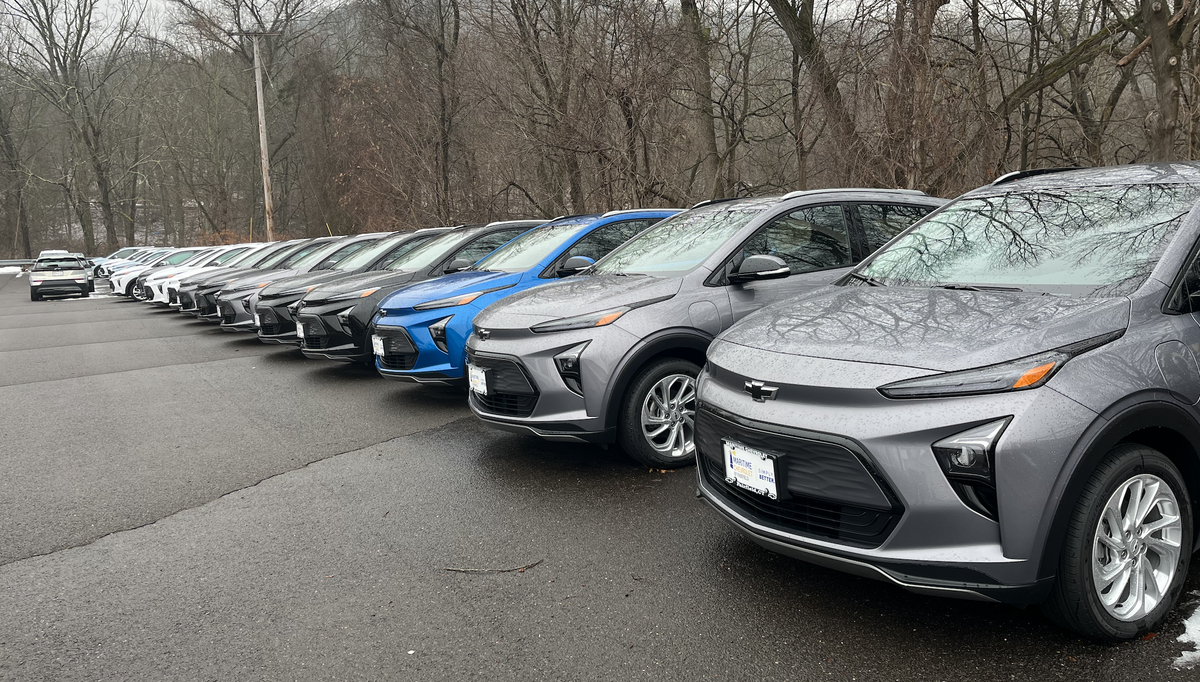
Nora Grace-Flood Photo
All charged up with nowhere to go: Yet-to-be-deployed city-owned Chevy Bolts lined up outside 200 Wintergreen Ave.

Nora Grace-Flood Photos
Climateers Max Teirstein, Steve Winter.
New Haven is starting small before going big — literally — as the city amps up its energy to go electric by 2030.
Climate Director Steve Winter shared that strategy during an aldermanic committee hearing regarding the status of the city’s Community Electrification Resolution.
“Please take electrification seriously,” Krishna Davis, a member of the New Haven Climate Movement, an organization that has been monitoring the city’s success towards meeting its own sustainability goals, said to kick off the meeting.
The alders’ City Services and Environmental Policy Committee met in the aldermanic chamber Thursday night to hear from Winter and Max Teirstein, who make up a two-person climate office launched after the passage of the resolution, about how New Haven is progressing towards the goal.
For example, what proportion of city-owned vehicles and buildings have been electrified so far? Fair Haven Alder Caroline Smith asked.
The answer is currently unclear. Winter did offer an estimate as to how many of the city’s 600-odd vehicles are electrified: 1 to 2 percent.
Winter gave examples of actions the city has taken so far as well as projects they need to launch down the line.
The underlying strategy, whether with buildings or vehicles, is to start small — and to focus on “heat pumps, heat pumps, heat pumps,” he said.
Currently, Winter said, his department is working with the engineering department to get electric heating systems inside the city’s smaller properties already in need of renovations. For instance, the Atwater Senior Center, police substations, and youth centers such as The Shack in West Hills are already equipped with electric heating or on their way there.
The smaller the building, the less complicated it is to overhaul the current space heating system, which typically makes up about two-thirds of an average building’s energy use, according to Winter. However, many of the spaces listed above, as well as stations at public parks, have already been allotted American Rescue Plan pandemic-relief dollars for renovations. With funding for infrastructural investment on tap, Winter is ensuring that electric heating is part of the game plan.
“We’re moving up to medium-sized buildings and looking at larger buildings,” Winter told the Independent. Atwater could count as “medium-sized” while buildings like City Hall or 200 Orange are large properties that will take more time to electrify.
As for vehicles, Winter reported that the city has purchased 43 Chevy Bolts to begin electrifying the city’s light duty fleet. Only seven of those have been deployed so far.
“I was leaving to get some lunch yesterday and saw a housing code inspector driving one,” Winter noted. The engineering department is also using the Bolts to get around town, as is the mayor.
The city will also receive a $7,500 reimbursement from the federal government for each Chevy purchased by the city, according to Winter.
It’s harder to find electric replacements for larger trucks, Winter said. And he has yet to pinpoint a perfect solution for vehicles like police patrol cars, which are often used for 24 hours at a time, such that charging could be not only an inconvenience but an impossibility.
Read more here about some recent work to install charging infrastructure around New Haven.
In the meantime, Winter mentioned he’s working on efforts to encourage future developers to go electric.
He’s drafting zoning language with the City Plan Department that could introduce a point system to grant developers density bonuses in exchange for integrating sustainable features like electric heating systems or solar panels or mass timber.
While each project pursued is contingent on several variables, including available grant funding, Winter said, he is further teaming up with the Finance Department to create a dashboard that will track energy use across the city’s major buildings by documenting gas and electric bills.
“What is the federal government doing?” East Rock Alder Anna Festa asked as Winter acknowledged funding limitations underlying slow electrification.
“I think the federal government is doing more now than it ever has before,” Winter responded. In the meantime, Winter said, he and Teirstein are filing as many grant applications as they can get their hands on.
“We’re lucky he’s applied for so many grants since he took that position,” Festa told her committee colleagues.
“Do we wish we could move faster? Absolutely,” she acknowledged. “One to two percent sounds so minimal, but it was done during a very short period of time.”
















No thanks. I'll leave that to the wokesters who need to project their wokeness and goodness. Flag me down, when you can't charge your battery. Maybe I'll give you a ride.
Hi to Steve Winter--- yet another potential mayoral candidate coopted by a cushy city "job"